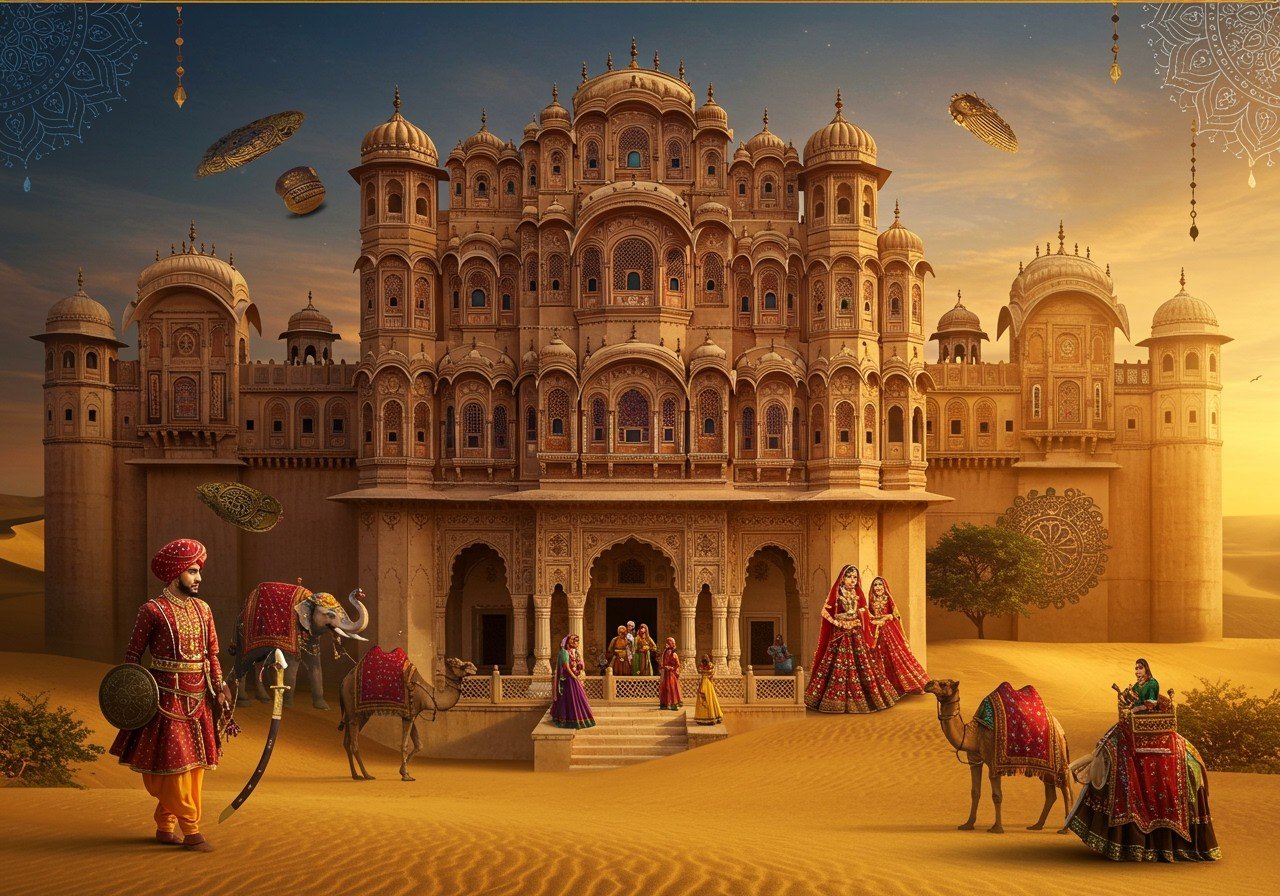
Rajasthan, the land of kings, is a treasure trove of history, culture, and tradition. It is the largest state in India, known for its majestic palaces, formidable forts, and vibrant festivals. This blog post delves into key aspects of Rajasthan’s history, exploring its ancient roots, significant events, and the enduring legacy it has left behind. This exploration provides a comprehensive understanding of Rajasthan’s historical journey, catering to culturally rooted Indians who value tradition and authenticity.
Ancient History of Rajasthan – Uncovering the Roots
To understand Rajasthan’s history, we must start with its ancient past. Evidence suggests human settlements existed as far back as 100,000 years ago. The Indus Valley Civilization thrived in the region between 5000 and 2000 BCE, with Kalibangan as a prominent site. Tribal cultures significantly shaped early history. The term ‘Rajput’ emerged, defining the warrior clans that rose to prominence in Rajasthan. Buddhism and Jainism profoundly influenced ancient Rajasthan. Ancient texts like ‘Prithviraj Raso’ offer valuable insights into this era. Invasions and migrations, including the arrival of the Aryans, further molded early Rajasthan, leading to architectural advancements such as early fortifications.
Medieval History of Rajasthan – Rise of Kingdoms
The medieval period witnessed the rise of powerful kingdoms and dynasties. Major Rajput kingdoms like Mewar, Marwar, and Amber were established. Legendary figures such as Maharana Pratap valiantly resisted Mughal Emperor Akbar’s dominance. The Delhi Sultanate and Mughal Empire significantly impacted Rajasthan. Important battles, including the Battle of Haldighati, left a lasting mark. This era saw remarkable cultural and architectural contributions, including magnificent forts and palaces. Rajput states developed unique socio-political structures and governance systems. Rajasthan played a crucial role in trade routes connecting the Indian subcontinent.
Colonial and Modern History of Rajasthan – Transformation
The colonial period brought significant changes to Rajasthan. The British established control over Rajput states, impacting the socio-economic structure. Rajasthan played a vital role in India’s struggle for independence, with key figures and movements emerging within the state. Post-independence, Rajput states integrated to form modern Rajasthan. The 20th century witnessed a cultural renaissance and dedicated efforts to preserve heritage sites. Architectural styles evolved during the colonial period, incorporating European influences. Rajasthan’s economy and infrastructure have developed significantly in the modern era.
Key Historical Events and Figures – Legends and Legacy
Rajasthan’s history is replete with significant events and legendary figures. Maharaja Sawai Jai Singh II founded Jaipur, a pivotal event in the region’s history. Maharana Kumbha contributed significantly to fort architecture and administration. Panna Dai’s bravery during the siege of Chittorgarh stands as a testament to courage and loyalty. Rana Sanga’s reign saw cultural and literary advancements. Raja Man Singh played a crucial role in shaping the region’s political landscape. Mirabai’s devotional poetry has left an enduring impact on Rajasthani culture. The Treaty of Ajmer was instrumental in establishing peace among warring factions.
Cultural and Architectural Heritage – A Visual Feast
Rajasthan is renowned for its rich cultural and architectural heritage. The use of red sandstone and marble defines Rajasthani architecture, with Mughal influences evident in many Rajput structures. Major forts like Amer Fort and Mehrangarh Fort showcase exquisite craftsmanship. Palaces such as the City Palace of Udaipur exude grandeur and elegance. Temples play a significant role in Rajasthan’s cultural landscape. Traditional crafts like textiles, pottery, and jewelry are passed down through generations. Folk music and dance forms like Ghoomar and Kalbeliya add vibrancy to Rajasthani culture. Festivals such as the Pushkar Camel Fair and Teej are vibrant celebrations of traditions. Poojn.in offers a wide selection of traditional mats and textiles, connecting you with Rajasthan’s rich heritage.
FAQs About Rajasthan’s History
How did Rajasthan get its name? The name “Rajasthan” translates to “Land of Kings,” reflecting its royal heritage and the numerous kingdoms that once flourished within its borders.
What is the origin of Rajput clans? Rajput clans trace their origins to various warrior tribes who settled and established their dominance in the region.
What role did Rajasthan play in India’s independence movement? Rajasthan contributed significantly to India’s struggle for freedom, with key figures and movements playing a vital role in the fight against colonial rule.
What were some major battles in Rajasthan’s history? Battles like Haldighati and Taragarh were pivotal moments in Rajasthan’s history, shaping the political landscape and leaving a lasting impact on the region.
Poojn.in: Your Gateway to Rajasthan’s Cultural Treasures
Connect with Rajasthan’s Heritage through Poojn.in: Discover a curated collection of products deeply rooted in Rajasthan’s traditions. From intricately designed puja items to handcrafted textiles, explore items that reflect the state’s rich cultural heritage.
- Authentic Ritual Items: Pooja essentials sourced directly from Rajasthan, ensuring quality and traditional authenticity.
Poojn.in provides detailed descriptions of each item, helping you understand its historical significance and traditional use. - Handcrafted Textiles: Discover traditional Rajasthani textiles, each piece telling a story of artistry passed down through generations.
Our collection includes a variety of textiles suitable for both rituals and everyday use.
Conclusion – The Timeless Grandeur of Rajasthan’s History
Rajasthan’s history is a captivating narrative of valor, culture, and enduring traditions. From ancient civilizations to powerful kingdoms and the transformations of the colonial era, each chapter of Rajasthan’s journey is filled with intrigue and grandeur. The legacy of its legendary figures, awe-inspiring architecture, and vibrant cultural heritage stands as a testament to Rajasthan’s enduring spirit. Understanding Rajasthan’s past deepens our appreciation for this majestic land. As we explore its timeless grandeur, we connect with the resilience and brilliance of our ancestors, honoring their traditions while embracing the convenience of preserving and celebrating this heritage in the modern age.


